API vs SDK vs Webhook - Various Ways to Power a Headless CMS
The ‘Headless’ CMS was born to help marketers implement a successful omnichannel content marketing strategy. Today, regardless of whether you are an individual marketer, freelance developer, or a large enterprise, you can rely on a Headless CMS for targeting audience conversion across emerging marketing channels. Headless CMSs harness the power of modern, scalable web development to help you deliver responsive content across all devices and platforms at a low cost, and in less time than traditional CMSs. With a Headless CMS you can escape all the hassles of a traditional CMS that mar the Developer Experience and Editor Experience, provided you are savvy about one aspect- How to power your Headless CMS?
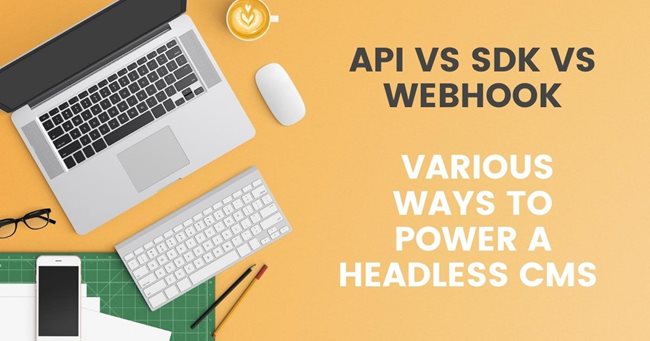
Setting up a content portal with a Headless CMS may require minimal tech support. But what stumps most content managers is how to power their Headless CMS. For professionals from a non-development background, it is a common misconception that with a headless CMS they can efficiently repurpose content across multiple channels (this much is true), and this can be done masterfully with either an SDK, or an API, or a Webhook. However, it is not an ‘either-or’ situation. APIs, SDKs, and Webhooks are used by developers to integrate new solutions that serve different purposes. A knowledgeable demystification of what role each of these play in powering Headless CMSs, can offer clarity to content makers, marketers, and moderators.
Headless CMS and API Integration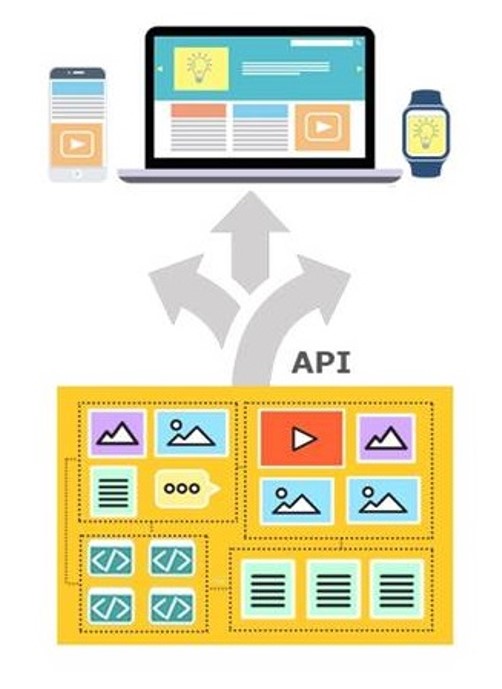
What is an API?
You may have come across the phrase API before. An API or an Application Programming Interface is a request-based, programmable intermediary that works between the server and the client-side to transmit data to and from. In a Headless CMS, The API accesses the content from the body i.e. backend repository and delivers it to the head i.e. backend only when a request is generated.
Over the years, Headless CMS developers have defined and redefined the way APIs power a Headless CMS. After all, the task of an API, in a decoupled CMS context, boils down to how well it serves content to its consumer, and how much freedom it gives content vendors over content presentation.
When should you use an API to power your Headless CMS?
In a nutshell, the APIs job in a Headless CMS context is to relay content as data between the viewer and the content repository. When a request is made from the client side, the API piggybacks the request to the server; the backend database completes the request. APIs remain idle unless a request is made by a third-party service or the user, that requires them to perform some action in response.
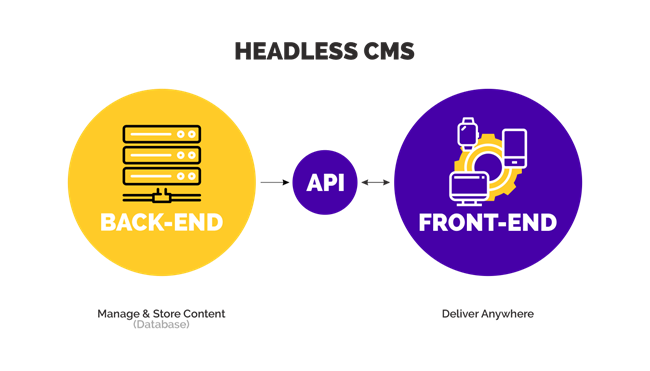
APIs can be critical difference makers in scenarios where the only server-side request processing facilitated by Webhooks simply does not cut it. Also, API-based CMS programming is more functional in scenarios where there is dynamic data to be managed, and thus actions are needed only on a request basis.
What role does it serve in engineering a Headless CMS?
Today, any Headless CMS worth its salt adopts an API-based architecture. With a decoupled, API-driven CMS at the helm of your content marketing, you only need a small dedicated team to maintain the security, frontend UI, and scalability aspects by leveraging the benefits of modern web development and design.
APIs play an intrinsic role in helping the CMS interact with external services using request-based commands. It speeds up processes and omits ‘dependencies’ such as hosting requirements and stack-specific code, which offers many benefits in terms of developers’ flexibility, security, and scalability.
Without having to worry about the code, or sticking to any one codebase, Content Publishers and Marketers can now focus on the quality of the content and the marketing aspects themselves. The API delivers content on any platform based on requests, presenting the content responsively as you have intended. In a market where mobile traffic has a 125% growth rate vs. 12% rate for desktop traffic, this pays rich dividends.
Headless CMS and SDKs
What is an SDK?
An SDK or a Software Development Kit is a set of programming ecosystems for developing platform-specific applications. SDKs come in handy when you need to write source code, compile and debug. SDKs provide you with the Integrated Development Environment (IDE) that you need to customize APIs, develop backend business logic and the frontend as well.
Please note that SDKs are not responsible for the actual day-to-day operation of your CMS. Their role is requirements-based, in the developmental and maintenance phases of an app life-cycle.
What role does it serve in engineering a Headless CMS?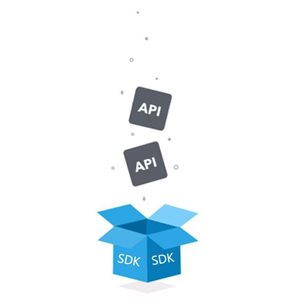
In a linear sense, an SDK can be considered a superset of APIs (SDKs are more than just that). It provides you with readymade libraries, modules, and APIs that help you code the functional aspects of your application. So, if APIs are responsible for the requests and responses in CMS operations, then SDKs are responsible for the comprehensive developmental tools that help you define those requests and responses.
We often labor under the impression that we have to choose between either an API or an ADK. However, that is not the case. The most successful Headless CMS services provide you with readymade APIs for common functions and features. However, should you require something out-of-the-box, you need only fall back on the SDKs provided by the CMS to concoct an API for the purpose.
When should you use an SDK to power your Headless CMS?
SDKs enable developers to create apps and work as the building blocks for your software. SDKs encompass sample code, GUIs for visually-enabled, fast, error-free development, and even APIs that give your content portal the most basic, conventional functions.
If the bundled APIs do not cut it, you can use the applicable SDK to create custom APIs as you require. Custom APIs help you enhance Page Management and Content Relationships- two parameters of utmost importance in managing for content editing and structuring.
SDKs allow your dedicated development team to scale up your content portal as required. As a result, content managers have a truly decoupled experience that is not marred by complex code; and, developers have platform-specific tools to create modules.
Headless CMS and Webhooks
What is a Webhook?
A Webhook is an event-based web callback whose primary role can be simplified to real-time information delivery (always) from the server-side to the client-side. In a rudimentary sense, they can be considered as reverse APIs, that are responsible for transmitting data from the source application (server) when an event triggers the process. Every time the content is updated, the Webhook configured into the Headless CMS notifies the endpoint with an automated message.
Besides real-time data transmitting capabilities, Webhooks can be used to customize business logic between the CMS backend and frontend. The event-based, conditional data pushing can be implemented with external services, thereby streamlining communication and notification, and structuring your content presentation.
What role does it serve in engineering a Headless CMS?
In a Headless CMS context, Webhooks can help you customize your frontend, add new features to your administration panel that allows you to curate a better content experience for your service users. However, Webhooks are not meant for augmenting customer-facing facilities alone.
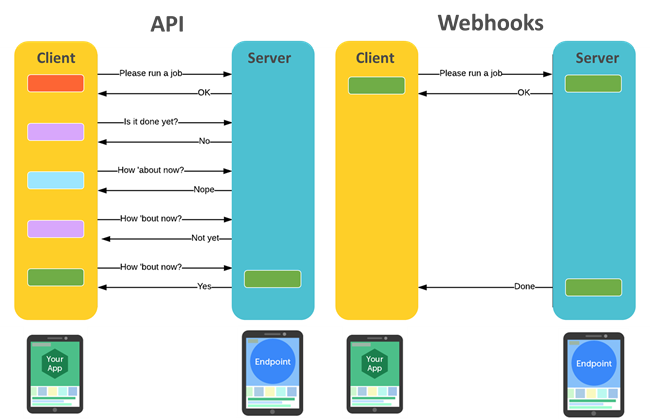
One can use Webhooks to clear and manage custom caches on external systems to give readers a personalized content consuming experience. You can also program them to provide notifications, and alerts that make CMS managers and editors’ jobs easier with custom workflows; synchronizing Webhooks a third-party mailing service can also efficiently tie up your content marketing strategy with your email marketing strategy. Content marketers with small, dedicated development support can also rely on Webhooks to facilitate a Continuous Integration/Continuous Delivery or Deployment (CI/CD) pipeline
When should you use a Webhook to power your Headless CMS?
Live-updating feeds based on consumer preference niches, updating new content notifications based on categorical consumer preferences, etc. are some real-time features created using Webhooks. In a market where 60% of creators commit to at least one content-piece a day, a real-time CMS is very much essential for content marketing.
You may not always find the right API for the job with the SDK accompanying your CMS. Webhooks can substitute the API as a low-end stopgap. Especially in scenarios where the trigger is event-based and not request-based.
Webhooks run on autopilot once they are set up, whereas APIs require development time. Also, since APIs are invoked manually with requests, they may not always serve the programming purpose. In such a scenario, automated Webhooks are more potent.
The gist of the matter
As you must be aware by now, APIs, Webhooks, and SDKs all serve unique and differential roles in powering your Headless CMS for concurrent, content marketing paradigms. The API carries information to and from in every event where a request is made, wherein the Webhook can only notify you about the event. Webhooks eschew manual intervention and require minimal coding knowledge to set-up; and, SDKs are responsible for creating/customizing both. It is understandable why professionals from a non-web development background may confuse all three to be alternatives or substitutes for each other. However, they are not; this clarification may further minimize your need for dedicated developer support, even if you are an individual with negligible or no programming experience.
Adaptive content is currently the toast of content marketing. A successful digital marketing strategy relies not only on quality content but on an adaptive, omnichannel content marketing system facilitated by modern web development. So, it is best practice for Headless CMS users to implement APIs, SDKs, and Webhooks in tandem for superior content structuring and personalization that paves the way for a powerful CMS experience.

Joel Varty
Joel Varty is President of Agility CMS. Joel has over 20 years of experience in customer relationship management, product management and has embraced cloud technology as a groundbreaking concept over a decade ago. Joel is a frequent writer for Agility CMS blog and leads many webinars and trainings for developers and digital leaders.